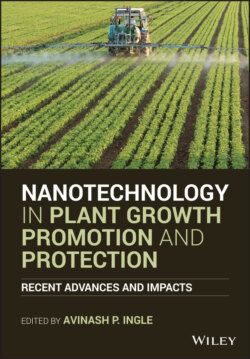Читать книгу Nanotechnology in Plant Growth Promotion and Protection - Группа авторов - Страница 43
2.6 Conclusion and Future Perspective
ОглавлениеThe application of TiO2NPs for crop enhancement is a relatively new phenomenon. The available reports clearly indicated that TiO2NPs influence and enhance plant growth. Most of the studies were done on germination or influence on young plants. The longer duration experiments with plants are still uncommon and the shortage of life cycle studies and multi‐generation studies leaves many unanswered questions. Other avenue that needs more research is the influence of soil types on the interaction between TiO2NPs and plants. Interaction between soils and nanoparticles is complex and can differ for particles of different sizes and coating. Measuring quantitative and qualitative uptake by plants can also provide more insight. Four areas of research need more focus in the following years.
1 Long term exposures at low doses: Models of fluxes in environmental compartments predict concentrations of ≤0.001–1000 mg/kg for bio‐solids including soils, with lower concentrations being much more common. Most of the studies were short term, with high concentrations used. Thus, there is a lack of knowledge of the actual environmental conditions in which the nanoparticles influence plant growth.
2 Nutritional quality and balance of essential elements in plants: TiO2NPs have been shown to affect the uptake of several essential elements including N, P, Ca, Na, Fe, Mn, and Zn. Therefore, it is important to study if nanoparticle use can cause imbalances in plant nutrition and to find what concentrations and which application times have the best effect on the promotion of uptake of the essential nutrient with the least negative effects on plants.
3 Intergenerational studies and uptake to edible parts: The influence of TiO2NPs or nanoparticles in general is understudied and little is known about the effects across multiple generations. The impact on seed integrity and growth of succeeding generations has been largely uninvestigated. There is also little knowledge about the concentrations of TiO2NPs in edible parts of the plants that can potentially compromise food safety.
4 Time and method of application: Although there is some evidence for differences between foliar and soil application, more research needs to be undertaken to increase the effect of the application of TiO2NPs on plants and decrease the contamination of soil by them. More comparative studies will provide greater insight and can limit the possible negative effects that the nanoparticles can have on the crops.
The body of knowledge that covers nanoparticle influence on plants is in the early stages and is largely incomplete. Some of the studies are relatively contradictory, but most of the evidence points toward low toxicity of TiO2NPs and great potential to enhance crop production at the right application time and concentration ranges. Great effort will be needed to complete the knowledge gaps and balance the potential between increased crop production and the safety of food and the environment.
